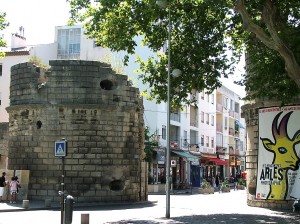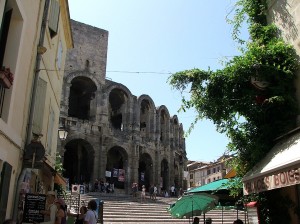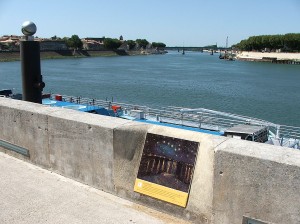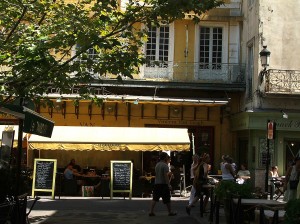2013-07-01: Sustainable Design Solutions are …
- Person-Centred ;
- Reliability-Based ; and most importantly
- Adapted to Local Context and Heritage (fr: le Patrimoine – see ICOMOS 2011) … geography, climate (incl. change, variability and severity swings), social need, culture, and economy, etc., etc.
‘Person-Centredness’ is a core value of Sustainable Human & Social Development … an essential principle in Sustainable Design … an indispensable support framework for Sustainability-related Policy and Decision-making … and an invaluable indicator when monitoring Sustainability Implementation.
.
Why so because ?
It is the mid-1990’s … in the centre of Dublin City.
Imagine, if you will, a very large historical building having a civic, justice-related function … and also an enormous Energy Bill. As described in a much earlier post, dated 2009-02-20, and the series of posts which followed on the subject of Building Energy Rating (BER) … we found that the most effective and practical remedy for this gaping and continuously haemorrhaging ‘energy’ wound was to approach the problem though the building’s users, their perception of thermal comfort, and International Standard ISO 7730.
The ‘real’ reduction in energy consumption, the ‘real’ increase in the building’s energy efficiency, and the ‘real’ improvements in building user / employee comfort and morale … were astounding !
.
 At a 1999 Strasbourg Conference in France … I delivered the following Paper …
At a 1999 Strasbourg Conference in France … I delivered the following Paper …
‘Person-Centredness’ of the Built Environment – A Core Value of Sustainable Design
.
INTRODUCTION from that Paper …
These are interesting times; the benefits of modern technology have bypassed and long overtaken the stirring thoughts, visions and catch cries of Architects at the beginning of the 20th Century. However, at this time in Europe, we must now ask ourselves some difficult questions …
“What should be the Design Agenda for the ‘Built Environment’ in the new millennium ?”
“Do we actually understand the ‘real’ needs and desires of ‘real’ people in an inclusive society ?”
It is Sustainable Design – the art and science of the design, supervision of related construction/de-construction, and maintenance of sustainability in the Built Environment – which is currently generating a quantum leap in the forward evolution of a more coherent design philosophy.
Principle 1 of the 1992 Rio Declaration on Environment and Development states …
‘Human beings are at the centre of concerns for sustainable development. They are entitled to a healthy and productive life in harmony with nature.’
Deeply embedded, therefore, within this philosophy is the concept of ‘person-centredness’, i.e. that core design value which places real people at the centre of creative concerns, and gives due consideration to their health, safety, and welfare in the Built Environment – it includes such specific performance criteria as: a sensory rich and accessible (mobility, usability, communications and information) environment; fire safety; thermal comfort; air, light and visual quality; protection from ionizing / electromagnetic radiation; nuisance noise abatement; etc. An important ‘person-centred’ design aid is the questionnaire survey, which is not only a very valuable source of information, but formalizes meaningful consultation between practitioners and end users.
SDI’s Guideline Framework on achieving equality of opportunity and social inclusion, which is based on a strategy produced by Directorate-General V of the European Commission, shows how further essential elements of ‘social wellbeing’ also relate to person-centredness; these include partnership between all sectors of society, consensus, transparency and openness.
This paper explores the rational and legal basis for person-centredness of the Built Environment in Europe. Fieldwork incorporating this innovative approach is also examined. Finally, a body of principles – a European Charter – is outlined which aims to ensure that new construction works, and renovated existing buildings, perform reliably, are adaptable, accessible and responsive, ‘intelligently green’ (French: intelli-verdure), cost-effective and inherently sustainable.
.
CLIMATE CHANGE ADAPTATION & MITIGATION POLICIES
AND BEFORE developing Climate Change Policies which will have such dramatic impacts on human populations, and their lifestyles, around the globe … perhaps those policies would be more effective, in the ‘real’ world and in the long-term … if we looked at the problem through the ‘eyes’ of people !
It will be worth taking a look at an interesting background paper produced by the World Bank in 2009 … whether you agree or disagree with the following statements …
“A lack of citizen understanding regarding the basics of climate science is an almost universal finding worldwide even though knowledge has increased over time. Especially notable is confusion between the causes of climate change and ozone depletion, and confusion between weather and climate.”
“North Americans know far less about climate change than their counterparts in the developed world.”
“Accurate and complete understanding of information is not a prerequisite for concern.”
“Concern is widespread around the world, but it may also be inversely correlated with the wealth and carbon footprint of a nation, or the socio-economic ‘class’ within a nation.”
“In some studies, more informed respondents reported less concern or sense of responsibility towards climate change.”
“People stop paying attention to global climate change when they realize that there is no easy solution for it. Many people judge as serious only those problems for which they think action can be taken.”
.
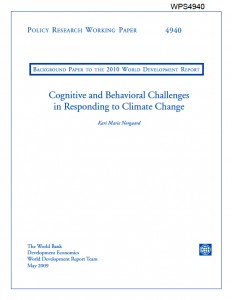 Policy Research Working Paper No.4940 (May 2009) – Kari Marie Norgaard
Policy Research Working Paper No.4940 (May 2009) – Kari Marie Norgaard
Cognitive & Behavioural Challenges in Responding to Climate Change (World Bank, 2009)
Click the Link Above to read and/or download PDF File (290 Kb)
This World Bank Working Paper – prepared as a background paper to the World Bank’s World Development Report 2010: Development in a Changing Climate. Policy Research Working Papers are posted on the Web at http://econ.worldbank.org
.
World Bank Working Paper 4940 (2009) – ABSTRACT …
Climate scientists have identified global warming as the most important environmental issue of our time, but it has taken over 20 years for the problem to penetrate the public discourse in even the most superficial manner. While some nations have done better than others, no nation has adequately reduced emissions and no nation has a base of public citizens that are sufficiently socially and politically engaged in response to climate change. This paper summarizes international and national differences in levels of knowledge and concern regarding climate change, and the existing explanations for the worldwide failure of public response to climate change, drawing from psychology, social psychology and sociology. On the whole, the widely presumed links between public access to information on climate change and levels of concern and action are not supported. The paper’s key findings emphasize the presence of negative emotions in conjunction with global warming (fear, guilt, and helplessness), and the process of emotion management and cultural norms in the construction of a social reality in which climate change is held at arms length. Barriers in responding to climate change are placed into three broad categories: 1) psychological and conceptual; 2) social and cultural; and 3) structural (political economy). The author provides policy considerations and summarizes the policy implications of both psychological and conceptual barriers, and social and cultural barriers. An annotated bibliography is included.
.
Is anybody learning yet ?
.
.
END


